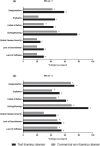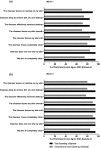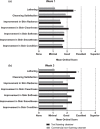Hydrophobically modified polymers can minimize skin irritation potential caused by surfactant-based cleansers
- PMID: 24305430
- PMCID: PMC4285286
- DOI: 10.1111/jocd.12061
Hydrophobically modified polymers can minimize skin irritation potential caused by surfactant-based cleansers
Abstract
Introduction: The addition of hydrophobically modified polymers (HMPs) to cleansers that contain surfactants can create polymer-surfactant complexes that are less irritating to the skin than commercially available mild cleansers. Our objective was to compare the tolerability and efficacy of a test foaming liquid facial cleanser containing HMPs with a commercial liquid nonfoaming facial cleanser in women with sensitive skin.
Methods: In this randomized, prospective, double-blind, comparative study, women (n = 20 per group) with mild-to-moderate atopic dermatitis (AD), eczema, acne, or rosacea used a test gentle foaming liquid facial cleanser containing HMPs or a commercial gentle liquid nonfoaming facial cleanser daily for 3 weeks. Investigators assessed irritation and skin condition. Study subjects also assessed their skin properties and the performance of each cleanser.
Results: Clinicians as well as study subjects consistently rated the test cleanser as effective or slightly more effective at improving symptoms than the commercial cleanser, although no significant differences between groups were observed. At weeks 1 and 3, respectively, more users of the commercial cleanser reported irritation (20% and 10%) than users of the test cleanser (5% and 5%). In addition, subject self-assessments of skin condition and cleansing properties were slightly more improved with the test cleanser than with the commercial cleanser.
Conclusions: Both the test foaming cleanser containing HMPs and the commercial nonfoaming cleanser were effective and well accepted by most women in the study. Improvements were observed by both clinicians and subjects in the group using the test cleanser containing HMPs in all evaluated skin categories.
Keywords: acne; atopic dermatitis; cleanser; eczema; irritation; skin; surfactant; tolerance.
© 2013 The Authors Journal of Cosmetic Dermatology Published by Wiley Periodicals, Inc.
Figures




References
-
- Abbas S, Goldberg JW, Massaro M. Personal cleanser technology and clinical performance. Dermatol Ther. 2004;17:35–42. - PubMed
-
- Ananthapadmanabhan KP, Moore DJ, Subramanyan K, et al. Cleansing without compromise: the impact of cleansers on the skin barrier and the technology of mild cleansing. Dermatol Ther. 2004;17:16–25. - PubMed
-
- Loffler H, Happle R. Profile of irritant patch testing with detergents: sodium lauryl sulfate, sodium laureth sulfate and alkyl polyglucoside. Contact Dermatitis. 2003;48:26–32. - PubMed
-
- Moore PN, Shiloach A, Puvvada S, Blankschtein D. Penetration of mixed micelles into the epidermis: effect of mixing sodium dodecyl sulfate with dodecyl hexa(ethylene oxide) J Cosmet Sci. 2003;54:143–59. - PubMed
Publication types
MeSH terms
Substances
LinkOut - more resources
Full Text Sources
Other Literature Sources

